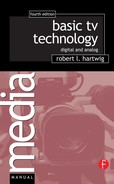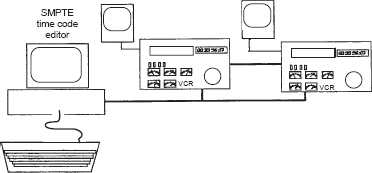In order to get broadcast-quality tape, edit with SMPTE time code.
SMPTE Time Code Editing
One of the problems of the editing methods discussed earlier is that it is difficult to make an accurate editing script or edit decision list (EDL). An EDL is a list of the scenes you want to use in the order in which you want to use them. You would list the beginning point of each scene and the ending point of each scene. The problem is how to record, accurately, what the scenes are. If you describe the beginning and ending points, you still have to search through the tape to find that particular scene. If you did several takes of the same scene, which one do you use? Or you could use the numbers on the tape machine counter. The problem here is that the counters are not accurate. Every time you take a tape off the machine and put it back on the numbers will change. The solution to this problem is SMPTE (Society of Motion Picture and Television Engineers) time code. SMPTE time code uses one of the audio tracks or a special address track that many formats have to lay down a specific code number for each frame of video information on the tape. This code consists of a time; for example, 00:27:14:03 would be read as 0 hour, 27 minutes, 14 seconds, and 3 frames. This system works well partly because there are 30 video frames per second.
Since each tape would normally start at 00:00:00:00, the above address would be almost halfway into an hour tape. The address is permanent. If the tape is taken off the machine and stored for a few years, 00:27:14:03 is going to be at exactly the same place on the tape coming out of the vault as it was when the tape went into the vault. Since many professional tapes are no more than an hour long, the hours column of the time code is generally used to identify the tape. For example, a time code of 05:36:56:24 would normally be 36 minutes, 56 seconds, and 24 frames into tape number 5.
The first advantage of SMPTE time code is that it makes putting together an editing script much easier and faster. With SMPTE time code, when you find the beginning or ending edit point, you simply write down the time code number. You don't have to write down a description of the aural or visual cues that indicate the edit points. Thus, it's much faster to go through a tape and put together an editing script. This is particularly important if the video is very long and/or complex, such as a television program.
Editing by SMPTE time code is much more expensive, but it is also much more precise and reliable. For this reason, and because the code enables you to more easily organize and manipulate large amounts of material, most broadcast tapes are edited using time code.
SMPTE time code editor.

